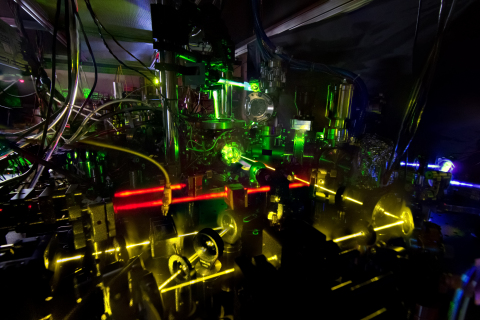Researchers have measured an optical clock’s ticking with
record-breaking accuracy while also showing the clock can be operated
with unprecedented consistency. These achievements represent a
significant step toward demonstrating that the new generation of optical
atomic clocks are accurate and robust enough to be used to redefine the
official length of a second, which is currently based on microwave
atomic clocks.
This press release features multimedia. View the full release here:
https://www.businesswire.com/news/home/20190411005556/en/

Caption: Researchers have measured this ytterbium optical clock’s ticking with record-breaking accuracy. The new work is a step toward redefining the length of a second based on time kept by an optical clock. Credit: Nate Phillips, NIST
“A more accurate definition of a second and a better time-keeping
infrastructure would support continuing advances in the timing systems
used in a wide range of applications, including communication and
navigation systems,” said Andrew Ludlow, one of the research team
leaders from the National
Institute of Standards and Technology (NIST), USA. “It would also
provide more precise measurements for exploring physical phenomena that
aren’t yet fully understood.”
The new research is reported in Optica,
The Optical Society’s journal for high impact research.
“Optical clocks are likely capable of much higher accuracy, probably 10
to 100 times better than what we measured in this work,” said Ludlow.
“To prove the true accuracy of these clocks without being limited by
today’s definition of a second will require high-quality comparisons
directly between various types of optical clocks.”
Why use an optical clock?
Clocks work by counting a reoccurring event with a known frequency, such
as the swinging of a pendulum. For traditional atomic clocks the
recurrent event is the natural oscillation of the cesium atom, which has
a frequency in the microwave region of the electromagnetic spectrum.
Since 1967, the International System of Units (SI) has defined a second
as the time that elapses during 9,192,631,770 cycles of the microwave
signal produced by these oscillations.
Optical atomic clocks use atoms such as ytterbium and strontium that
oscillate about 100,000 times higher than microwave frequencies, in the
optical, or visible, part of the electromagnetic spectrum. These higher
frequencies allow optical clocks to tick faster than microwave atomic
clocks, making them more accurate and stable over time.
“The higher frequencies measured by optical clocks generally make it
easier to control environmental influences on the atoms,” said Tara
Fortier, a member of the research team. “This advantage could eventually
enable the development of compact optical clock systems that maintain
relatively high performance in a wide range of application environments.”
Achieving record accuracy
To show that time kept with an optical clock is compatible with today’s
standard cesium atomic clocks, the researchers converted the frequency
of an ytterbium optical atomic clock at NIST to the microwave region and
compared it with a collection of measurements from cesium atomic clocks
located across the globe.
They achieved frequency measurements of the ytterbium optical clock with
an uncertainty of 2.1 X 10-16. This corresponds to losing
only about 100 seconds over the age of the universe (14 billion years)
and sets a new accuracy record for cesium-referenced measurements of an
optical clock.
Although optical clocks are very accurate, they do tend to experience
significant downtimes because of their technical complexity and
prototype design. The researchers at NIST used a group of eight hydrogen
masers to keep the time when the optical clock wasn’t operational.
Masers, which are like lasers that operate in the microwave spectral
range, can reliably keep time but have limited accuracy.
“The stability of the masers — one of the best local time scales in the
world — is one reason why we were able to perform such an accurate
comparison to cesium,” said Tom Parker, a member of the research team.
They further reduced the uncertainty by making 79 measurements over 8
months. This is the first time that optical clock measurements have been
reported over such a long time period.
To better understand the limits of optical clocks, the researchers plan
to compare the ytterbium optical clock used in this study with other
types of optical clocks under development at NIST. Eventually, the NIST
clocks could be compared with optical clocks in other countries to
determine which types of clocks would be best for redefining the SI
second.
The researchers point out that redefining the length of a second is
still some years away. Even if it does change, applying the new standard
would require technology that better connects and transmits signals from
optical clocks around the world in a way that maintains stability and
the accuracy of the time.
Paper: W. F. McGrew, X. Zhang, H. Leopardi, R.J. Fasano, D.
Nicolodi, K. Beloy, J. Yao, J. A. Sherman, S. A. Schäffer, J. Savory,
R.C. Brown, S. Römisch, C.W. Oates, T.E. Parker, T.M. Fortier, A.D.
Ludlow, “Towards the optical second: Verifying optical clocks at the SI
limit,” Optica, 6, 4, 448-454 (2019).
DOI: https://doi.org/10.1364/OPTICA.6.000448
About Optica
Optica is an open-access, online-only journal dedicated to the
rapid dissemination of high-impact peer-reviewed research across the
entire spectrum of optics and photonics. Published monthly by The
Optical Society (OSA), Optica provides a forum for pioneering
research to be swiftly accessed by the international community, whether
that research is theoretical or experimental, fundamental or applied. Optica
maintains a distinguished editorial board of more than 50 associate
editors from around the world and is overseen by Editor-in-Chief Alex
Gaeta, Columbia University, USA. For more information, visit Optica.
About The Optical Society
Founded in 1916, The Optical Society (OSA) is the leading professional
organization for scientists, engineers, students and business leaders
who fuel discoveries, shape real-life applications and accelerate
achievements in the science of light. Through world-renowned
publications, meetings and membership initiatives, OSA provides quality
research, inspired interactions and dedicated resources for its
extensive global network of optics and photonics experts. For more
information, visit osa.org.
View source version on businesswire.com: https://www.businesswire.com/news/home/20190411005556/en/